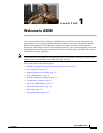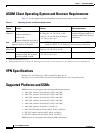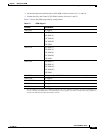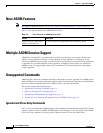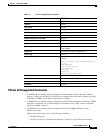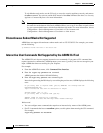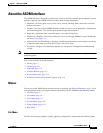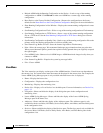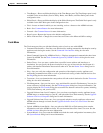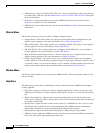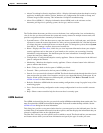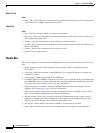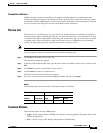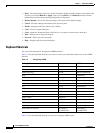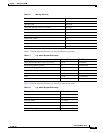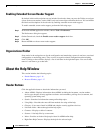
1-9
Cisco ASDM User Guide
OL-16647-01
Chapter 1 Welcome to ASDM
About the ASDM Interface
• Time Ranges—Shows and hides the display of the Time Ranges pane. The Time Ranges pane is only
available for the Access Rules, Service Policy Rules, AAA Rules, and Filter Rules panes in the
configuration view.
• Global Pools—Shows and hides the display of the Global Pools pane. The Global Pools pane is only
available for the NAT Rules pane in the configuration view.
• Find—Locates an item for which you are searching, such as a feature or the ASDM Assistant.
• Back—See Common Buttons for more information.
• Forward—See Common Buttons for more information.
• Reset Layout—Returns the layout to the default configuration.
• Office Look and Feel—Changes the screen fonts and colors to the Microsoft Office settings.
Tools Menu
The Tools menu provides you with the following series of tools to use with ASDM:
• Command Line Interface—Provides a text-based tool for sending commands to the adaptive security
appliance and viewing the results. See the
Command Line Interface dialog box for more
information.
• Show Commands Ignored by ASDM on Device—Displays unsupported commands that have been
ignored by ASDM. See the
Show Commands Ignored by ASDM on Device dialog box for more
information.
• Packet Tracer—Lets you trace a packet from a specified source address and interface to a
destination. You can specify the protocol and port of any type of data and view the lifespan of a
packet, with detailed information about actions taken on it. See the
Packet Tracer dialog box for
more information.
• Ping—Lets you verify the configuration and operation of the adaptive security appliance and
surrounding communications links, as well as perform basic testing of other network devices. See
the
Ping dialog box for more information.
• Traceroute—Lets you determine the route packets will take to their destination. See the Traceroute
dialog box for more information.
• File Management—Lets you view, move, copy, and delete files stored in Flash memory. You can also
create a directory in Flash memory. See the
File Management dialog box for more information. You
can also display the File Transfer dialog box to transfer files between various file systems, including
TFTP, Flash memory, and your local PC.
• Upgrade Software from Local Computer—Lets you choose an adaptive security appliance image,
ASDM image, or another image on your PC, and upload the file to Flash memory. See the
Upgrade
Software from Local Computer dialog box for more information.
• Upgrade Software from Cisco.com—Lets you upgrade adaptive security appliance software and
ASDM software through a wizard. See the
Upgrade Software from Cisco.com Wizard for more
information.
• Upload ASDM Assistant Guide—Lets you upload an XML file to Flash memory that contains
information used in the ASDM Assistant. You can download these files from Cisco.com. See the
ASDM Assistant dialog box for more information.
• System Reload—Lets you restart the ASDM and reload the saved configuration into memory. See
the
System Reload dialog box for more information.



